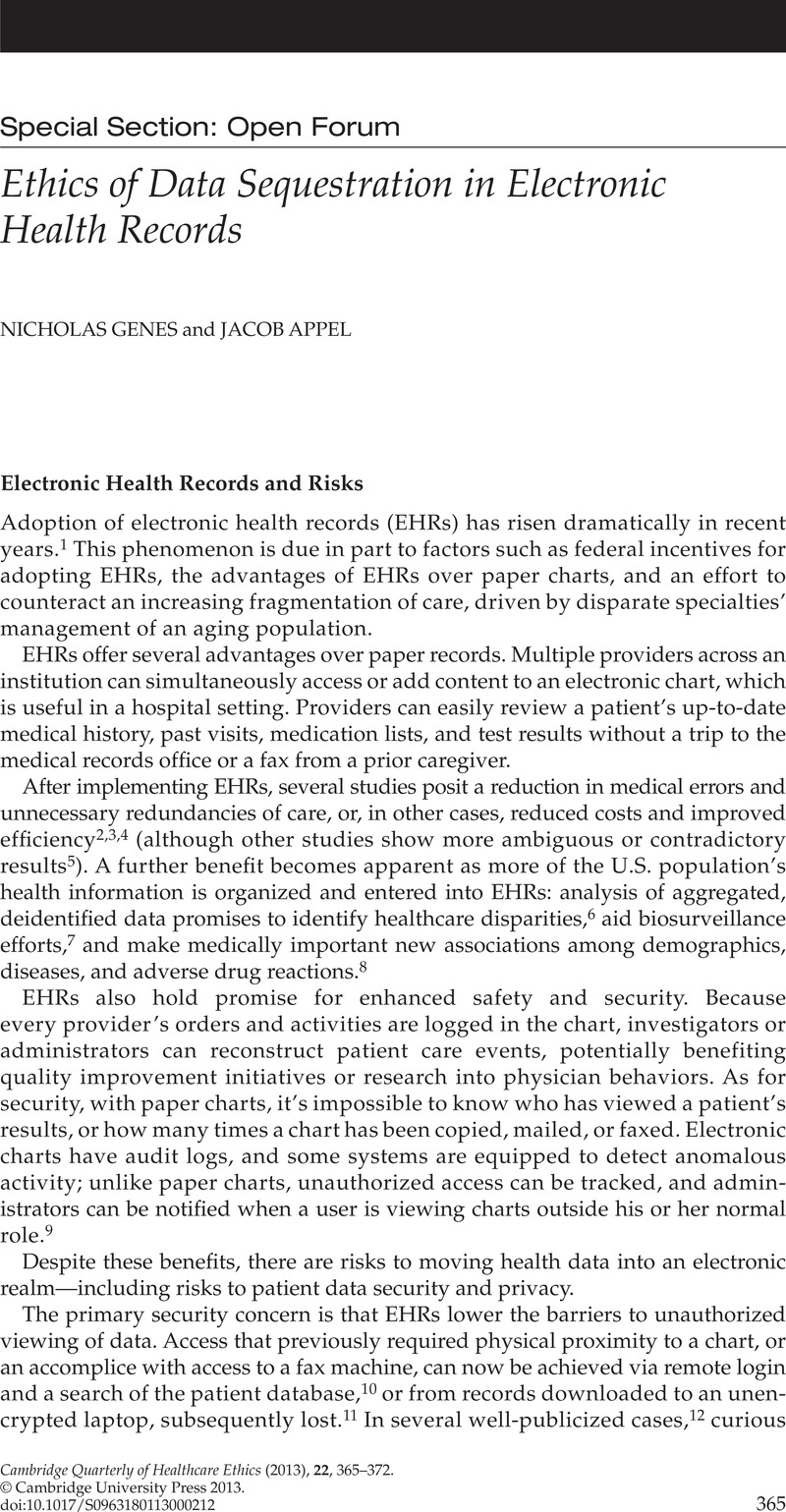Article contents
Ethics of Data Sequestration in Electronic Health Records
Published online by Cambridge University Press: 06 August 2013
Abstract

- Type
- Special Section: Open Forum
- Information
- Copyright
- Copyright © Cambridge University Press 2013
References
Notes
1. Jha, AK, Burke, MF, DesRoches, C, Joshi, MS, Kralovec, PD, Campbell, EG, et al. . Progress toward meaningful use: Hospitals’ adoption of electronic health records. American Journal of Managed Care 2011 Dec;17(12 Spec No.):SP117–24.Google Scholar
2. Baumlin, KM, Shapiro, JS, Weiner, C, Gottlieb, B, Chawla, N, Richardson, LD.Clinical information system and process redesign improves emergency department efficiency. Joint Commission Journal of Quality and Patient Safety 2010 Apr;36(4):179–85.Google Scholar
3. Silow-Carroll, S, Edwards, JN, Rodin, D.Using electronic health records to improve quality and efficiency: The experiences of leading hospitals. Issue Brief (Commonwealth Fund) 2012 Jul;17:1–40.Google ScholarPubMed
4. Zlabek, JA, Wickus, JW, Mathiason, MA.Early cost and safety benefits of an inpatient electronic health record. Journal of the American Medical Informatics Association 2011 Mar–Apr;18(2):169–72.Google Scholar
5. Jones, SS, Adams, JL, Schneider, EC, Ringel, JS, McGlynn, EA.Electronic health record adoption and quality improvement in US hospitals. American Journal of Managed Care 2010 Dec;16(12 Suppl HIT):SP64–71.Google ScholarPubMed
6. Pantazos, K, Lauesen, S, Lippert, S.De-identifying an EHR database—anonymity, correctness and readability of the medical record. Studies in Health Technology and Informatics 2011;169:862–6.Google Scholar
7. Rea, S, Pathak, J, Savova, G, Oniki, TA, Westberg, L, Beebe, CE, et al. . Building a robust, scalable and standards-driven infrastructure for secondary use of EHR data: The SHARPn project. Journal of Biomedical Informatics 2012 Aug;45(4):763–71.Google Scholar
8. Churchill, R, Lorence, D, Richards, M. Proposed model for ONCHIT pre-case biosurveillance using multiple array sensing and non-invasive data capture. Journal of Medical Systems 2010 Aug;34(4):695–700.Google Scholar
9. Boxwala, AA, Kim, J, Grillo, JM, Ohno-Machado, L.Using statistical and machine learning to help institutions detect suspicious access to electronic health records. Journal of the American Medical Informatics Association 2011 Jul–Aug;18(4):498–505.Google Scholar
10. Mohammad, Y, Stergioulas, L.Building an information security strategy for EHR: Guidelines for assessing the current situation. Conference Proceedings of the IEEE Engineering in Medicine & Biology Society 2010:3919–22.Google ScholarPubMed
11. Kowalczyk L. MGH to pay 1m to settle privacy case. Boston Globe 2011 Feb 25.
12. Lambert B, Schweber N. Hospital workers punished for peeking at Clooney file. New York Times 2007 Oct 10.
13. Losefsky, W.The efficacy of best practices in recovery from cyberattacks. Journal of Healthcare Protection Management 2012;28(1):104–7.Google ScholarPubMed
14. Haugh, R.Cyber terror. Hospitals & Health Networks 2003 Jun;77(6):60–4, 2.Google ScholarPubMed
15. Lamberg, L.Confidentiality and privacy of electronic medical records: Psychiatrists explore risks of the “information age.” JAMA 2001 Jun 27;285(24):3075–6.Google Scholar
16. See note 15, Lamberg 2001.
17. Salomon, RM, Blackford, JU, Rosenbloom, ST, Seidel, S, Clayton, EW, Dilts, DM, et al. . Openness of patients’ reporting with use of electronic records: Psychiatric clinicians’ views. Journal of the American Medical Informatics Association 2010 Jan–Feb;17(1):54–60.Google Scholar
18. Miaoulis, W.Sequestering EHR data in IT systems. Journal of American Health Information Management Association 2009 May;80(5):50–1.Google Scholar
19. Weingart, SN, Simchowitz, B, Padolsky, H, Isaac, T, Seger, AC, Massagli, M, et al. . An empirical model to estimate the potential impact of medication safety alerts on patient safety, health care utilization, and cost in ambulatory care. Archives of Internal Medicine 2009 Sept 14;169(16):1465–73.CrossRefGoogle Scholar
20. Chisolm, DJ, Purnell, TS, Cohen, DM, McAlearney, AS.Clinician perceptions of an electronic medical record during the first year of implementaton in emergency services. Pediatric Emergency Care 2010 Feb;26(2):107–10.CrossRefGoogle ScholarPubMed
21. Shapiro JS. Evaluating public health uses of health information exchange. Journal of Biomedical Informatics 2007 Dec;40(6 Suppl):S46–9.
22. Johnson, KB, Unertl, KM, Chen, Q, Lorenzi, NM, Nian, H, Bailey, J, et al. . Health information exchange usage in emergency departments and clinics: The who, what, and why. Journal of the American Medical Informatics Association 2011 Sep–Oct;18(5):690–7.Google Scholar
23. Frisse, ME, Johnson, KB, Nian, H, Davison, CL, Gadd, CS, Unertl, KM, et al. . The financial impact of health information exchange on emergency department care. Journal of the American Medical Informatics Association 2012 May–Jun;19(3):328–33.Google Scholar
24. Blumenthal, D.Implementation of the federal health information technology initiative. New England Journal of Medicine 2011 Dec 22;365(25):2426–31.Google Scholar
25. Rothstein, MA.The Hippocratic bargain and health information technology. Journal of Law, Medicine & Ethics 2010 Spring;38(1):7–13.Google Scholar
26. See note 25, Rothstein 2010, at 5.
- 4
- Cited by




